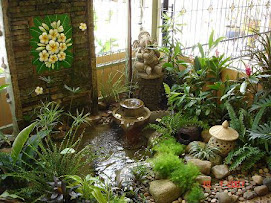Gardens - Garden Tips 7
By Ted Wosko and Sandra Wosko
Hi Everyone
Yet again another great week although you can really tell the temperature is dipping over night now, as we have to clear our windscreens and it is just about time for the old sweatshirt to go on over the polo I am wearing.
Rusty our dog made me laugh the other morning. It was probably the coldest day we have had recently, and usually when it is time for me to go to work rusty comes outside with me so I can throw his ball for him a couple of times before I leave. This morning when I opened the door and the cold wind hit him he just stood there and looked up at me as to say 'if you think I am going out there today you have another thing coming', that is certainly the character we love about him. When I picked his ball up the temptation was just too much and out he shot like a speeding bullet.
Work wise we are just about on top of things now with the entire amount of grass cutting we have been doing. We have just completed a grass- seeding job for a landfill site – only 11 acres, just a bit larger than normal size garden. Basically it is the same process as we do for new lawns in a home garden but we are using much larger mechanical machinery.
If you are preparing your lawn at home you would first loosen up the ground with a rotovator and you would end up with fine tilth - meaning fine small granules of topsoil without large lumps. You must also remove large and small stones from the surface, rake over to get the surface as level as possible. A good tip here is to get a piece of board about 4 foot long, place on the surface and pull back towards yourself. This will help you get the ground level by taking out the humps and filling in the holes- easy hey! When you are happy with the result, step back and repeat until you have completed the whole area to be seeded.
You should now have a nice level base to sow the grass seed. Place the seed into a bucket and hold in the middle against your stomach. Now stand at the edge of the new lawn area, using your free hand grab a handful of seed, you then broadcast the seed by moving your hand forwards, outwards and across your body at the same time opening your hand up as you go. This sequence should spread the seed nice and quite evenly across the whole area. Take a step forward and repeat the process until the whole area is completed.
You can then go back and put seed on any parts you have missed or the seed is a bit thin. Next get a grass rake and rake the area over covering the grass seed with the soil. Do not worry about trying to cover all the seed, as it will still grow. You can then get your board and re-level the area in the same manner as before, if you have a garden roller you can use it to give it a light roll- but it is not essential. Now give the lawn a good sprinkling of water and leave alone.
After about two to three weeks depending on the weather you should start to see some growth. Once it starts it will soon thicken up to leave the whole area in your garden looking like a new green carpet. Allow the grass to grow to about 2 to 3 inches long before cutting. Reduce the length of the lawn slowly, take at least three cuts over a period of three weeks to take it down to no shorter that 1 inch in height. Till next time just enjoy your gardens.
Ted & Sandra
This article was composed by Ted and Sandra Wosko of A-Z Landscapes & Contract Services Ltd. We run a very successful uk based landscaping family company. We have some blue chip companies as our clients and been retained by them for several years. We have been acknowledged for helping companies achive their environmental compliance standards.
http://www.topgardensuk.com
http://www.theaudiobookdownload.com
http://www.learnturnandearn.com
Article Source:ezinearticles.com


